
Mastering the Marketplace: The Indispensable Role of Shopping Vocabulary Worksheets
In an increasingly globalized world, the ability to communicate effectively in English is paramount, especially in practical, everyday scenarios. Among these, shopping stands out as a universal activity that often requires specific linguistic skills. Whether navigating a bustling supermarket in London, bargaining in a souk in Marrakech, or simply making an online purchase from an international vendor, a strong command of shopping-related vocabulary is essential. At the heart of mastering these interactions are shopping vocabulary worksheets – powerful educational tools designed to equip learners with the precise language needed to shop with confidence and clarity.
This comprehensive article will delve into the profound importance of shopping vocabulary worksheets, exploring their multifaceted benefits, the rich content they typically encompass, the diverse audience they serve, and practical strategies for maximizing their effectiveness. We will also touch upon how to find or even create your own high-quality worksheets, underscoring their role as a cornerstone of practical English language acquisition.

The Undeniable Importance of Shopping Vocabulary Worksheets

Why dedicate specific learning resources to shopping vocabulary? The reasons are numerous and compelling:
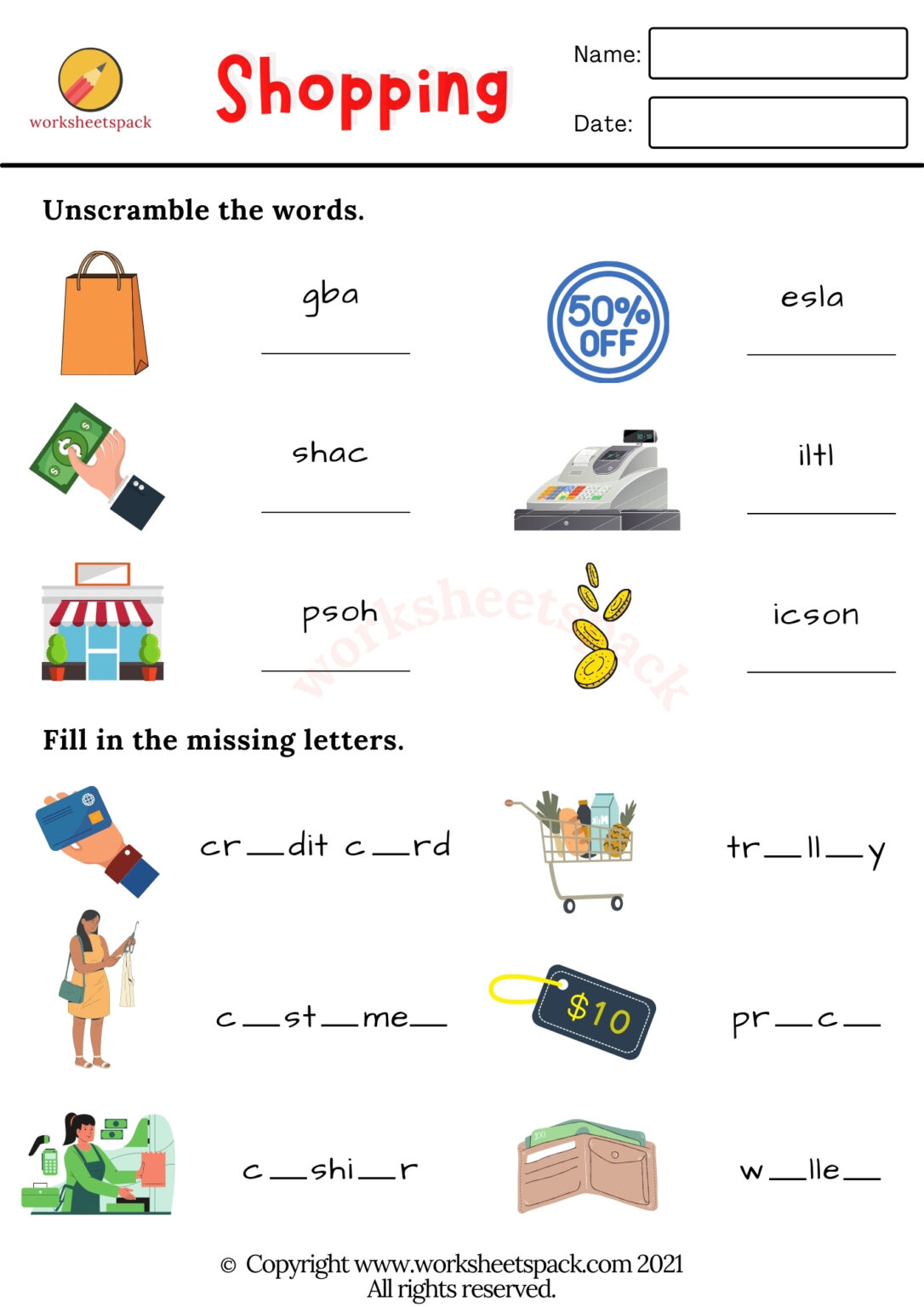
-
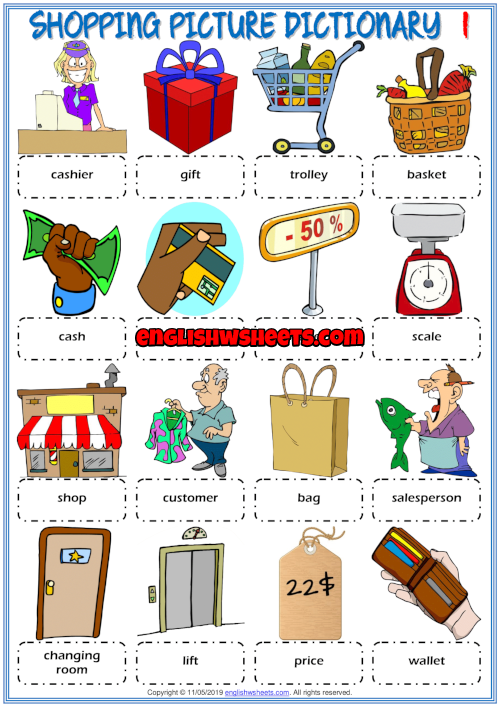
Practical Life Skill: Shopping is not an abstract concept; it’s a fundamental part of daily life. From buying groceries and clothes to ordering food and paying bills, these interactions are frequent and necessary. Lacking the appropriate vocabulary can lead to frustration, misunderstandings, and even financial errors. Shopping vocabulary worksheets bridge this gap, preparing learners for real-world situations.
-
Building Confidence: For language learners, especially those in an immersive environment or planning to travel, the fear of misunderstanding or being misunderstood can be paralyzing. Knowing the specific terms for items, quantities, prices, and interactions empowers individuals to participate actively and confidently in shopping scenarios, reducing anxiety and fostering a sense of independence.
-
Enhancing Cultural Immersion: Shopping is often deeply intertwined with culture. Understanding nuances like polite phrases for requesting items, terms for different types of stores (e.g., department store, boutique, convenience store), or even local payment methods enriches the cultural experience. Worksheets can introduce these cultural contexts alongside the vocabulary.

-
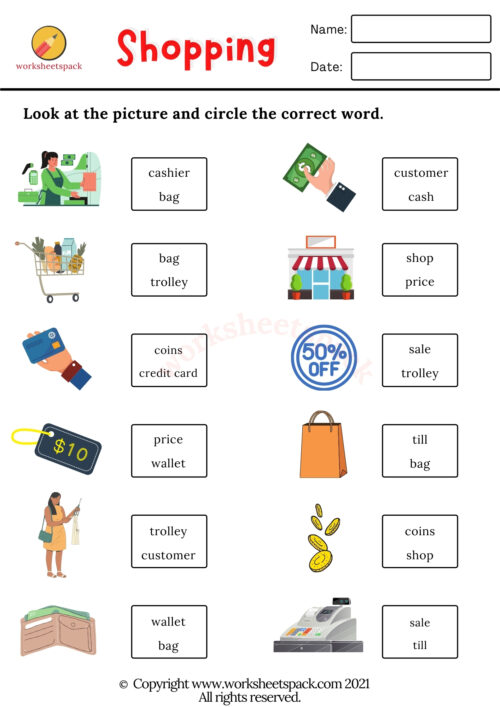
Career Relevance: For those aspiring to work in retail, hospitality, customer service, or even international trade, a robust shopping vocabulary is not just useful but critical. It directly impacts their ability to serve customers, understand inventory, handle transactions, and resolve issues effectively.
-
Beyond General English: While general English courses cover foundational vocabulary, they often lack the specialized lexicon required for specific domains. Shopping vocabulary is highly contextual and includes terms that might not appear in everyday conversational lessons. Worksheets provide that focused, targeted learning.

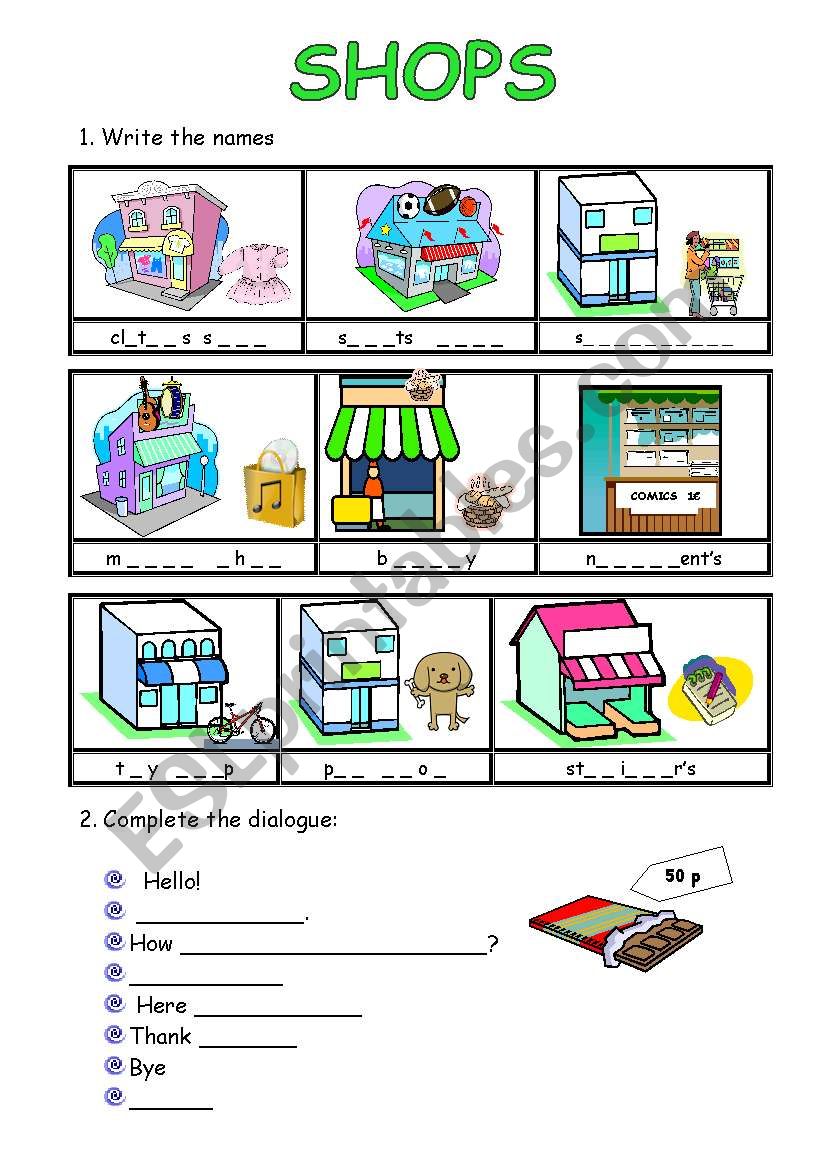
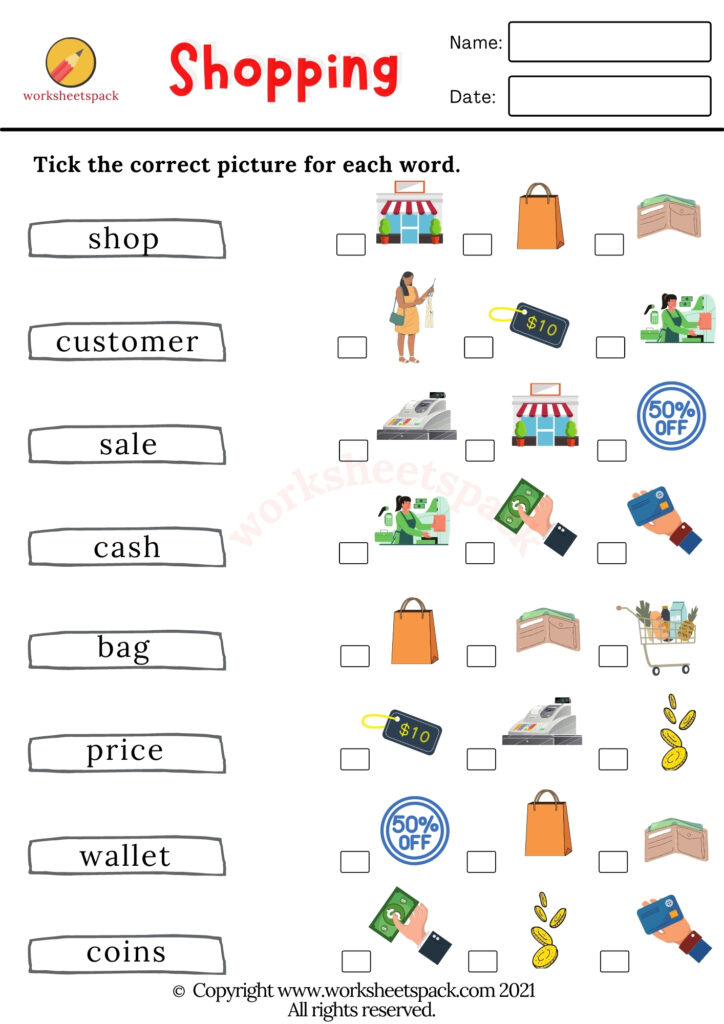
What Do Effective Shopping Vocabulary Worksheets Contain?
An effective set of shopping vocabulary worksheets will encompass a broad spectrum of terminology and exercise types to cater to different learning styles and levels. The content typically covers:
A. Core Vocabulary Categories:
- Places to Shop: supermarket, grocery store, department store, mall, boutique, pharmacy, bakery, butcher shop, fishmonger, convenience store, hardware store, electronics store, bookshop, online store, flea market, farmers’ market, discount store, outlet.
- People Involved: customer, shopper, buyer, shop assistant, sales clerk, cashier, manager, vendor, seller, tailor, pharmacist, baker.
- Actions & Verbs: buy, sell, pay, purchase, shop for, browse, try on, bargain, negotiate, return, exchange, refund, order, deliver, pick up, wrap, weigh, measure, ask for, inquire, complain, checkout.
- Items & Goods:
- Groceries: fruits, vegetables, meat, poultry, fish, dairy, bread, pastries, cereals, canned goods, frozen food, spices, condiments, beverages.
- Clothing: shirt, pants, dress, skirt, jacket, coat, shoes, boots, sneakers, accessories, size, color, fabric.
- Electronics: phone, laptop, TV, headphones, charger, appliance.
- Household Items: cleaning supplies, toiletries, furniture, decor.
- Services: delivery, gift wrapping, alterations, repairs.
- Pricing & Payment: price, cost, discount, sale, special offer, bargain, receipt, bill, change, cash, credit card, debit card, mobile payment, currency, tax, tip.
- Quantities & Measurements: kilo, gram, liter, milliliter, dozen, pair, piece, slice, bottle, can, carton, pack, bunch, loaf.
- Common Phrases & Expressions: "Can I help you?", "How much is this?", "Do you have this in another size/color?", "I’m just looking.", "Where is the changing room?", "Is this on sale?", "I’d like to pay by card.", "Can I get a refund/exchange?", "It’s too expensive.", "That’s a good deal."
- Adjectives for Describing Products: cheap, expensive, affordable, durable, fragile, fresh, ripe, organic, new, used, trendy, classic, comfortable, stylish.
B. Diverse Exercise Types:
To make learning engaging and effective, high-quality shopping vocabulary worksheets incorporate a variety of exercise formats:
- Matching: Pairing words with definitions, pictures, or synonyms/antonyms.
- Fill-in-the-Blanks: Completing sentences with appropriate shopping vocabulary.
- Multiple Choice: Selecting the correct word or phrase from a given set of options.
- Crosswords & Word Searches: Fun ways to reinforce vocabulary recognition.
- Sentence Completion: Using target vocabulary to complete partial sentences, often requiring contextual understanding.
- Role-Playing Scenarios: Simulating real-life shopping conversations (e.g., customer and shop assistant, bargaining at a market).
- True/False Statements: Testing comprehension of shopping-related facts or scenarios.
- Picture Labeling: Identifying items or actions in shopping-themed images.
- Categorization: Grouping words into logical categories (e.g., "types of stores," "payment methods").
- Discussion Prompts: Open-ended questions to encourage learners to use the new vocabulary in communicative contexts.
- Gap-fill Dialogues: Completing conversations with missing shopping phrases.
Who Benefits from Shopping Vocabulary Worksheets?
The utility of shopping vocabulary worksheets extends across a wide demographic:
- ESL/EFL Learners: From beginners needing basic terms for survival shopping to advanced learners refining their nuanced expressions, these worksheets are invaluable.
- Travelers: Individuals planning trips abroad can quickly acquire the necessary vocabulary to navigate foreign markets and stores.
- New Immigrants: Settling in a new country involves frequent shopping; these resources provide essential language for daily living.
- Students Preparing for Standardized Tests: While not always direct, practical vocabulary can appear in listening or reading comprehension sections of exams like IELTS or TOEFL.
- Retail and Customer Service Professionals: Those working or aspiring to work in roles that involve customer interaction can significantly enhance their professional communication.
- Teachers: Educators of all levels can utilize these worksheets as ready-made lesson materials or as inspiration for creating their own.
- Parents: Teaching children about money, budgeting, and shopping can be made more engaging with vocabulary-focused activities.
How to Maximize the Impact of Shopping Vocabulary Worksheets
Simply completing a worksheet isn’t enough; active engagement and strategic application are key to long-term retention and practical usage.
- Integrate with Real-Life Scenarios: Whenever possible, connect the worksheet content to actual shopping experiences. Before a trip to the supermarket, review relevant vocabulary. After a shopping trip, discuss what items were purchased and how the transactions unfolded.
- Utilize Multimedia: Supplement worksheets with authentic materials. Watch short videos of shopping scenarios, look at online store websites, read product descriptions, or analyze real receipts. This provides context and visual reinforcement.
- Prioritize Speaking Practice: Role-playing is incredibly effective. Encourage learners to act out dialogues from the worksheets or create their own. This builds fluency and confidence in speaking.
- Regular Review and Reinforcement: Vocabulary acquisition is an ongoing process. Revisit completed worksheets, use flashcards, or create personalized word lists. Spaced repetition techniques can be highly beneficial.
- Personalize the Content: If creating your own worksheets, tailor them to the specific needs and interests of the learners. For example, if they are interested in fashion, focus more on clothing vocabulary.
- Make it Fun and Interactive: Incorporate games, quizzes, or competitive elements. Learning should be enjoyable to maintain motivation.
- Combine with Grammar: While focused on vocabulary, integrate grammatical structures commonly used in shopping, such as questions ("How much is…?"), requests ("Could I have…?"), and comparisons ("This is cheaper than…").
Creating Your Own or Finding Quality Shopping Vocabulary Worksheets
The availability of shopping vocabulary worksheets is vast, ranging from free online resources to comprehensive paid curricula.
A. Where to Find Quality Worksheets:
- ESL/EFL Websites: Many reputable websites dedicated to English language learning offer free printable worksheets (e.g., ESL-Lab, BusyTeacher, Teach-This, ISLCollective).
- Educational Marketplaces: Platforms like Teachers Pay Teachers provide a wide array of resources, often created by experienced educators, for a small fee.
- Textbooks and Workbooks: Dedicated ESL textbooks often include units on shopping with accompanying exercises.
- Language Learning Apps: Some apps incorporate vocabulary drills and scenarios related to shopping.
- Libraries: Public and university libraries may have resources for language learners.
B. Tips for Creating Your Own Worksheets:
If you can’t find exactly what you need, creating your own worksheets allows for maximum customization:
- Identify Learning Gaps: Determine which specific shopping vocabulary areas your learners struggle with.
- Focus on Relevancy: Include words and phrases that are most likely to be encountered in real-life situations.
- Vary Exercise Types: Mix and match different activity formats to keep learners engaged and cater to diverse learning styles.
- Incorporate Visuals: Pictures, illustrations, and real-life images (e.g., product labels, store signs) enhance comprehension and memorization.
- Provide Context: Don’t just list words; put them into sentences, dialogues, or short passages to demonstrate their usage.
- Include an Answer Key: This allows for self-correction and independent learning.
- Start Simple and Build Complexity: Begin with basic vocabulary and gradually introduce more complex terms and phrases.
Conclusion
In essence, shopping vocabulary worksheets are more than just learning tools; they are indispensable bridges connecting theoretical language knowledge to practical, everyday application. They empower learners to confidently navigate one of life’s most common and essential activities, transforming potentially daunting encounters into opportunities for successful communication and cultural immersion. By providing targeted vocabulary, diverse exercise types, and practical contexts, these worksheets lay a solid foundation for independent and effective interaction in the global marketplace. Whether you are a student, a teacher, a traveler, or simply someone looking to enhance your English skills, embracing the power of shopping vocabulary worksheets is a smart investment in practical language mastery.
